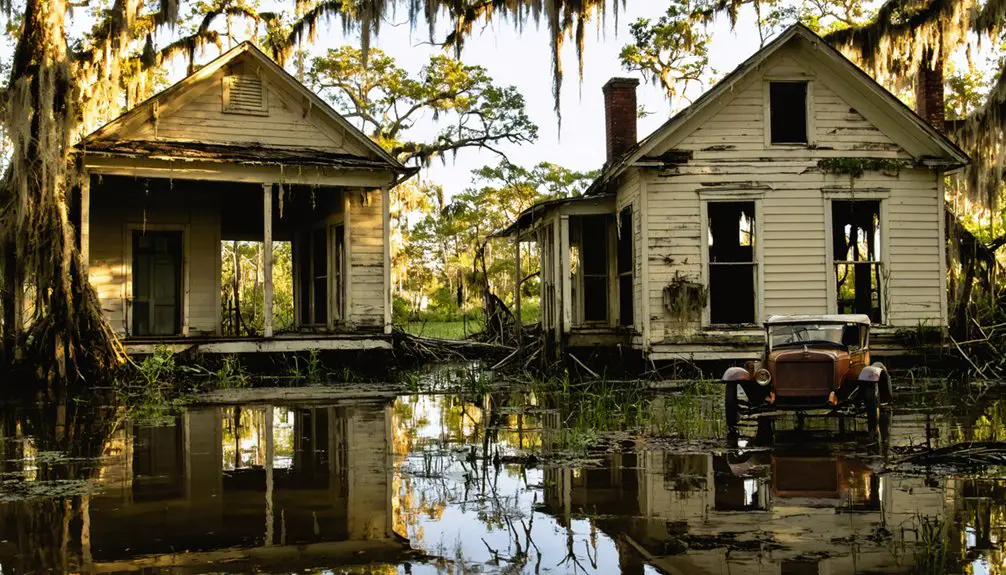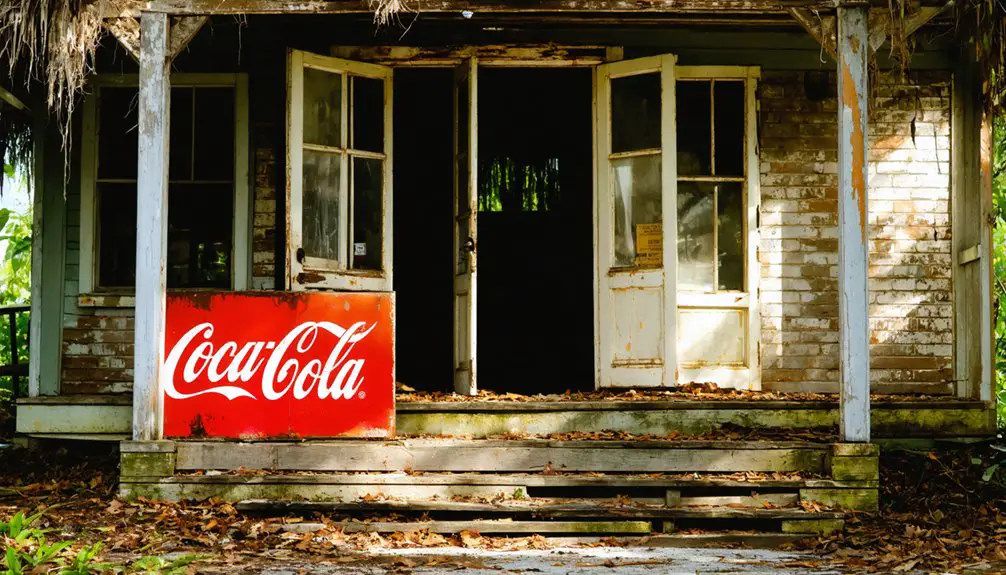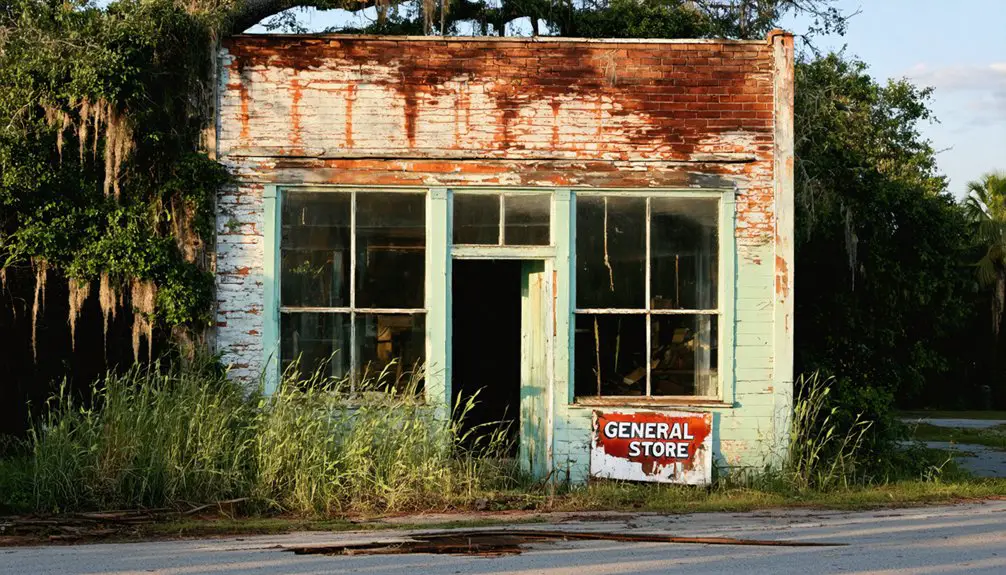You’ll find the lost town of Chosen along Lake Okeechobee’s southeastern shore, where J.R. Leatherman established a Christian pietist settlement in the early 1900s. The community thrived with diverse settlers, a U.S. Post Office, and the Church of the Brethren until September 16, 1928, when a catastrophic hurricane brought 150 mph winds and an 18-foot wave that breached the muck dike. The disaster claimed over 2,300 lives and transformed fertile farmland into a haunting reminder of nature’s power.
Key Takeaways
- Founded by J.R. Leatherman in the early 1900s, Chosen was established as a religious settlement near Lake Okeechobee.
- The town featured a U.S. Post Office, school, and Church of the Brethren, serving approximately ten families by 1922.
- Chosen’s economy centered around agriculture, utilizing rich soil near Lake Okeechobee for farming.
- The devastating 1928 hurricane brought 150 mph winds and an 18-foot wave, killing over 2,300 residents and destroying the town.
- After the 1928 hurricane, Chosen was abandoned and became a ghost town, with only archaeological remains marking its existence.
Origins of the Name and Early Settlement
While indigenous peoples like the Mayaimi and Calusa Indians originally inhabited the area around present-day Chosen, building ceremonial mounds and living harmoniously with the natural environment, the town itself wouldn’t emerge until the early 1900s when J.R. Leatherman, a Christian pietist from Virginia, established the settlement. A severe drought in 1900 revealed remnants of earlier settlements in the region.
The name significance of Chosen likely stems from the settlers’ religious convictions rather than local geographic features or founder names. Much like Chaim Potok’s novel The Chosen explored religious identity, the town’s naming reflected deep spiritual meaning to its founders. You’ll find that community aspirations and pietist beliefs shaped the town’s identity, as reflected in its unique name suggesting divine favor or spiritual election.
The Pioneering Vision of J.R. Leatherman
J.R. Leatherman’s Christian pietist background profoundly shaped his vision for Chosen as both a spiritual and agricultural community in early 20th century Florida.
You’ll find his influence evident in the establishment of key institutions like the Brethren church he founded in 1922, which served about ten patriarch families at its peak, and the U.S. Post Office that helped put the settlement on the map.
In 1921, he established Chosen as a religious haven where residents could live and work together in harmony. As an Elder who’d previously served congregations in Virginia and other Florida locations, Leatherman’s leadership style emphasized simplicity and moral living while attracting diverse settlers including merchants, farmers, and laborers to this religious-minded frontier town. His tenure as Elder was cut short when he was removed from his position for moral misconduct in April 1925.
Religious Roots Shape Community
The spiritual vision of preacher J.R. Leatherman shaped Chosen’s identity through faith-driven resilience and communal identity. Born to German Brethren parents in 1865, he brought his architectural skills and religious leadership to establish this remote Florida settlement near Lake Okeechobee in 1921. The 1928 hurricane ultimately destroyed the faithful community and its structures. Like the later inventor Timothy Leatherman who spent years refining his concept, J.R. Leatherman dedicated significant time to perfecting his community’s design and function.
- Daily life centered around shared religious values and fellowship.
- The town’s layout reflected Brethren principles of simple living.
- A church and school formed the heart of community activities.
- Strict codes of conduct guided collective decision-making.
Leatherman’s role as Elder and builder helped structure both the physical and spiritual framework of Chosen. His Brethren background emphasized communal settlement principles, which strengthened the town’s resolve through environmental challenges until its eventual destruction in the 1928 hurricane.
Building From The Ground
From the bedrock of religious conviction emerged a pioneering settlement that would redefine Florida’s frontier landscape. Under J.R. Leatherman’s vision, Chosen’s community infrastructure took shape with remarkable efficiency.
By 1922, you’d find a U.S. Post Office run by Brethren member Isaac West, a school where Bertha Albin taught for six years, and a church that served as both spiritual sanctuary and meeting hall.
The town’s development reflected an unexpected cultural diversity, welcoming not just Brethren families but also merchants, fishermen, and black farm laborers. Like many Florida communities of the era, Chosen’s development required careful oversight to prevent neglect of duty by local officials.
Leatherman’s planning capitalized on the area’s rich soil near Lake Okeechobee, establishing migrant housing and packing warehouses to support a burgeoning agricultural economy. His all-encompassing approach transformed raw land into a structured community poised for growth.
Indigenous Heritage and Sacred Grounds
Long before settlers established the town of Chosen, this land held deep spiritual and cultural significance for indigenous peoples spanning thousands of years.
The Mayaimi and Calusa tribes maintained sacred mounds and ceremonial grounds here, practicing their indigenous traditions until the 17th century. Archaeological discoveries reveal a rich tapestry of cultural life, with artifacts showing extensive trade networks and sophisticated architectural practices. The Smithsonian Institute conducted extensive excavations of these settlements in the 1930s.
Ancient tribes crafted elaborate mounds and sacred spaces, leaving behind rich evidence of their advanced trading and architectural achievements.
- Ceremonial mounds served as both burial grounds and spiritual centers for nearly 5,000 years
- Spanish trade beads found at the site evidence early European contact and trading
- The Mayaimi people, part of the Belle Glade Culture, built village mounds between 200-600 A.D.
- These sacred grounds connected to a broader network of coastal and inland indigenous societies
Sadly, modern development and agricultural expansion have erased most visible traces of these sacred mounds.
Daily Life in a Lake Okeechobee Community
If you lived in Chosen during the 1920s, you’d have spent your days tending to crops in the rich soil surrounding Lake Okeechobee, where the Hillsboro Canal provided essential irrigation for farming.
You’d join your neighbors for thrice-immersion baptisms and religious services at the Church of the Brethren, which served as the community’s spiritual and social center.
Life moved according to agricultural seasons and religious observances, with families gathering at the local schoolhouse and sharing in collective farm work that reflected their Dunkard values of simplicity and mutual aid.
Farming Around The Lake
While fishing initially sustained the communities around Lake Okeechobee, agriculture emerged as the dominant way of life after fish stocks depleted in 1912.
You’d find pioneering farmers developing diverse farming techniques on Ritta and Torry Islands, where they cleared native pond apple trees to make way for crop diversity. The rich muck soil, though challenging to work with, supported everything from vegetables to sugar cane. Farmers found that winter vegetable crops thrived particularly well in the region’s climate. The shallow clay deposits beneath the soil created unique drainage challenges for agriculture.
- 700-acre operations transformed islands into productive farmland
- Early settlements featured general stores, schools, and local governance
- Farmers battled environmental challenges like flooding and soil management
- Mechanized equipment revolutionized farming by mid-20th century
Canal systems helped control water levels, making year-round farming possible despite the constant threat of flooding.
You’d see families adapting their agricultural practices to overcome the region’s unique environmental challenges.
Community Social Gatherings
The Church of the Brethren‘s religious values shaped every aspect of social life in Chosen after its 1921 founding. You’d find yourself immersed in a close-knit community where church gatherings, baptism ceremonies, and communal dinners formed the heart of social bonding.
The town’s school and church halls buzzed with storytelling sessions and cultural exchanges. When you weren’t farming, you’d join neighbors for fish fries, rodeos, and parades that strengthened community resilience.
The waterways around Lake Okeechobee connected you to nearby settlements, while local markets and businesses served as vibrant social hubs. Living near ancient Mayaimi Indian mounds, you’d participate in historical commemorations that honored the region’s indigenous heritage.
These gatherings fostered solidarity until the devastating 1928 hurricane dispersed the community.
The Fateful Storm of 1928

On September 16, 1928, a catastrophic hurricane with winds reaching 150 mph slammed into Florida’s Lake Okeechobee region, releasing 18 inches of rain within 24 hours and forever altering Chosen’s destiny.
When a 17-foot wave breached the muck dike, a devastating wall of black water engulfed the town, destroying homes, farms, and essential infrastructure. The hurricane’s impact proved insurmountable for Chosen’s survival.
- Over 2,300 residents and migrant workers perished in the flood waters
- Mass graves and burials at Port Mayaca Cemetery revealed stark racial segregation
- The town’s agricultural lands were rendered useless by the muddy devastation
- Chosen never recovered, while nearby communities like Belle Glade rebuilt
This tragic event led to the construction of the Herbert Hoover Dike, but for Chosen, it marked the beginning of its transformation into a ghost town.
Archaeological Discoveries and Lost Artifacts
Archaeological excavations in the 1930s revealed remarkable discoveries beneath Chosen’s flood-ravaged ruins when Smithsonian researchers unearthed extensive Calusa Indian settlements at the “Indian Mound” site.
You’ll find evidence of a thriving indigenous culture in the pottery, tools, and shell jewelry they discovered, though preserving these treasures proved challenging. The wetland environment that initially protected these artifacts began working against their preservation once they were exposed.
Today’s archaeological techniques have revolutionized how we study Chosen’s past. Using ground-penetrating radar and drone technology, you can explore ancient settlements without disturbing them.
Modern technology lets archaeologists peek into the past without disrupting ancient sites, revealing hidden stories beneath our feet.
These methods have revealed impressive 220-foot fortification walls and shell-enclosed dwellings surrounded by towering oyster shell ridges, offering glimpses into both Native American life and early Spanish expeditions that once crossed these lands.
From Thriving Town to Agricultural Fields

Beyond the ancient artifacts and shell mounds lies a story of transformation that reshaped Chosen’s landscape forever.
You’ll find that the agricultural evolution began after the devastating 1928 hurricane, when a 17-foot wall of water obliterated the town’s structures and forced survivors to flee. This community decline marked the end of Chosen as a residential settlement, but it wasn’t the end of the land’s productivity.
- The rich muck soil that once attracted settlers now supports vast sugarcane operations
- Former home sites and streets have vanished beneath agricultural fields
- No residential structures remain in what was once a thriving farming community
- The land’s evolution showcases nature’s power to reshape human settlements
The area’s conversion to intensive agriculture demonstrates how catastrophic events can permanently alter a region’s destiny, trading urban dreams for rural productivity.
Preserving the Memory of Chosen
Despite Florida’s broad preservation movement starting in 1978, Chosen’s physical remnants have largely vanished from both memory and landscape.
You’ll find no Indian mounds, original structures, or historic markers where this once-vibrant community stood – only sprawling sugar fields remain.
The town’s memory preservation now relies heavily on historical documentation, particularly accounts of the devastating 1928 hurricane that claimed thousands of lives.
While archaeological surveys have mapped numerous ghost towns across Florida, Chosen’s story remains significantly underrepresented in formal preservation efforts.
The mass graves and stories of black farm workers and white pioneers who perished serve as stark reminders of the community’s tragic end.
Without physical landmarks, oral histories and archival records have become essential lifelines to understanding Chosen’s significance in Florida’s complex past.
Legacy in Florida’s Historical Landscape

Through its complex legacy, Chosen stands as a poignant reminder of Florida’s layered history, where indigenous Calusa settlements, Christian pietist ambitions, and agricultural development converged near Lake Okeechobee.
You’ll find the town’s cultural continuity echoed in archaeological findings and historical records, even though its physical structures have vanished beneath agricultural fields.
- The site represents Florida’s highest concentration of ghost towns east of the Mississippi
- Archaeological evidence links ancient Calusa civilization to early 20th-century settlers
- The 1928 hurricane’s impact continues to influence modern flood control strategies
- Local oral histories preserve the community’s environmental resilience through generations
Today, while Chosen’s visible remnants may be gone, its significance in shaping Florida’s historical landscape endures through academic research, archaeological studies, and the collective memory of those who study the region’s past.
Frequently Asked Questions
What Was the Total Population of Chosen at Its Peak?
You’ll find population statistics suggest Chosen’s peak reached roughly 150-200 residents, based on historical significance and comparisons to similar Florida ghost towns like Oriole and Mannfield during the same era.
Were There Any Attempts to Rebuild Chosen After the 1928 Hurricane?
Like a candle snuffed out forever, there weren’t any documented rebuilding efforts or signs of community resilience. You’ll find the town quickly turned to sugarcane fields as residents scattered to nearby communities.
What Crops Did the Original Settlers Primarily Grow in Chosen?
You’ll find sugarcane dominated the landscape, alongside vegetable gardens and experimental sisal hemp crops. While some settlers tried cotton cultivation and citrus farming, the wet conditions favored sugarcane’s resilience.
Did Any Buildings or Structures From Chosen Survive the Hurricane?
You won’t find any surviving structures from that fateful 1928 hurricane impact – the devastating Okeechobee storm completely destroyed Chosen, leaving nothing but memories and a historical marker to mark its existence.
How Many Families Originally Settled in Chosen With J.R. Leatherman?
You’ll find that about 10 core Brethren settler families originally joined J.R. Leatherman in founding Chosen, though they were later joined by additional merchants and farm laborers who diversified the community.
References
- https://en.wikipedia.org/wiki/Chosen
- https://www.ghosttowns.com/states/fl/chosen.html
- https://freepages.history.rootsweb.com/~gtusa/usa/fl.htm
- https://jacquithurlowlippisch.com/tag/chosen-florida/
- https://patchproflorida.com/blog/the-fascinating-history-of-floridas-ghost-towns/
- https://www.onlyinyourstate.com/experiences/florida/underwater-ghost-town-fl
- https://www.youtube.com/watch?v=ov9YSsKtbDs
- https://abandonedfl.com/mannfield/
- http://pbchistory.blogspot.com/2016/07/the-short-life-and-sudden-end-of-gods.html
- https://www.theneighborlyfl.com/p/a-place-called-chosen



